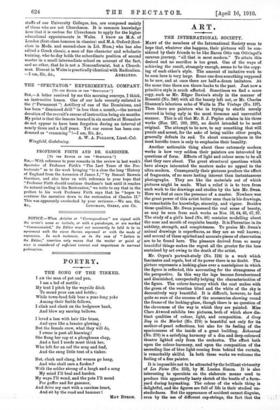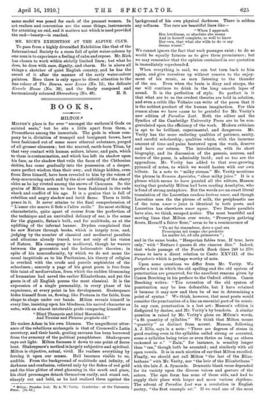ART.
THE INTERNATIONAL SOCIETY.
MANY of the members of the International Society seem to hope that, whatever else happens, their pictures will be con- sidered by their friends to be like Baron Otto von Ottringel's caravan journey, " all that is most modern." To attain this desired end no sacrifice is too great. One of the ways of achieving the result, strangely enough, seems to be the copy- ing of each other's style. The amount of imitative work to be seen here is very large. Some one does something supposed to be new, and at once there are half-a-dozen imitators. At the same time there are throw-backs to the past. Just now a primitive style is much affected. Sometimes we find a mere copy, such as Mr. Edgar Davies's study in the manner of Rossetti (No. 249) with all the beauty left out, or Mr. Charles Shannon's laborious echo of Watts in The Vintage (No. 197). Then there are painters who in trying to startle merely succeed in being ugly in the most tiresome and uneventful manner. This is all that Mr. S. J. Peploe attains in his three works (Nos. 287, 288, 289), no doubt intended to be most original. The attempt to be new, to say something that will puzzle and arrest, for the sake of being unlike other people, generally defeats its end. To shout commonplaces in the most horrific tones is only to emphasise their banality.
Another noticeable thing about these extremely modern works is how very seldom their painters are interested by questions of form. Effects of light and colour seem to be all that they care about. The great structural questions which have always interested the masters make no appeal to the ultra-modern. Consequently their pictures produce the effect of fragments, of no more lasting interest than instantaneous photographs. They are like the materials out of which pictures might be made. What a relief it is to turn from such work to the drawings and studies by the late Mr. Swan. Here we feel at once the presence of a master. Nowhere was the great power of this artist better seen than in his drawings, so remarkable for knowledge, sincerity, and vigour. Besides these qualities, Mr. Swan possessed the real sense of beauty, as may be seen from such works as Nos. 58, 64, 65, 67, 97. The study of a girl's head (No. 66) contains modelling about the nose and mouth of exquisite beauty. It is Florentine in its subtlety, strength, and completeness. To praise Mr. Swan's animal drawings is superfluous, as they are so well known ; and several of these spirited and accurate pieces of observation are to be found here. The pleasure derived from so many beautiful things makes the regret all the greater for the loss sustained by art owing to the death of the artist.
Mr. Orpen's portrait-study (No. 124) is a work which fascinates and repels, but of its power there is no doubt. The picture represents a looking-glass over a mantelpiece in which the figure is reflected, this accounting for the strangeness of the perspective. In this way the legs become foreshortened and diminished, unexpectedly helping the characterisation of the figure. The colour-harmony which the coat makes with the green of the venetian blind and the white of the sky is decoratively very beautiful. It is difficult, however, to feel quite so sure of the success of the accessories showing round the frame of the looking-glass, though there is no question of the cleverness of the way in which they are painted. Miss Glare Atwood exhibits two pictures, both of which show dis. tinct qualities of colour, light, and composition. A Grey Day in the Market (No. 270) is beautiful not only for its mother-of-pearl reflections, but also for its feeling of the spaciousness of the inside of a great building. Rehearsal (No. 278) is a satisfying harmony of a dim and deep-coloured theatre lighted only from the orchestra. The effect both upon the colour-harmony, and upon the composition of the ascending line of blue light coming from behind the curtain, is remarkably skilful. In both these works we welcome the feeling of a fine painter.
It is impossible not to be attracted by the brilliant virtuosity of Les Pains (No. 253), by M. Lucien Simon. It is also interesting to speculate on the elaborate means used to produce this apparently hasty sketch of the bustle of a farm. yard during haymaking. The colour of the whole thing is delightful, and the figures are full of life in their studied un• studiedness. But the appearance of accident cannot disguise, even by the use of different cap-strings, the fact that the same model was posed for each of the peasant women. In art realism and convention are the same things, instruments for attaining an end, and it matters not which is used provided the end—beauty—is reached.
' MR. RICH'S EXHIBITION AT THE ALPINE CLUB. To pass from a highly diversified Exhibition like that of the International Society to a room full of quiet water-colours by one man is to experience a feeling of calm and repose. Mr. Rich has chosen to work within strictly limited lines ; but what he does, he does with ease, dignity, and charm. He is above all things a sketcher of quiet English country, and he has the secret of it after the manner of the early water-colour painters. Here there is only space to direct attention to the fine colour of The Downs, near Lewes (No. 12), the delicate Knowle House (No. 38), and the finely composed and harmoniously coloured Shrewsbury (No. 48). H. S.















































 Previous page
Previous page